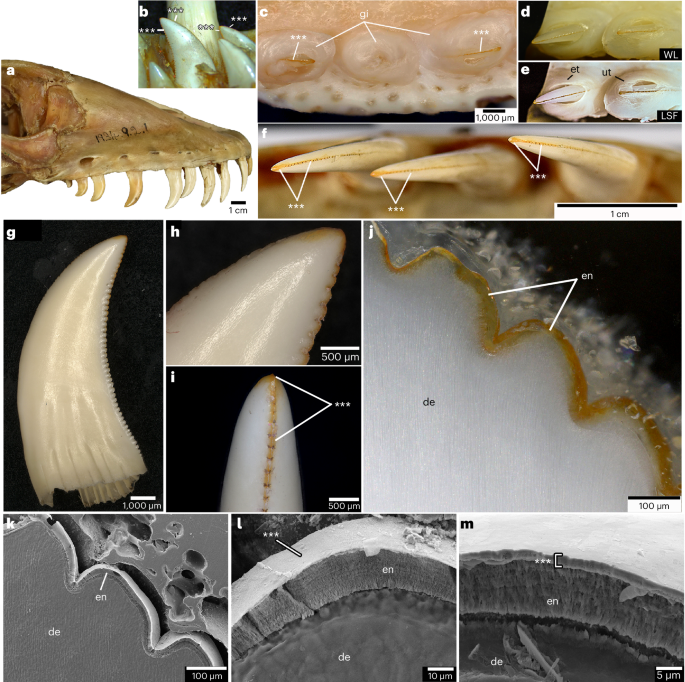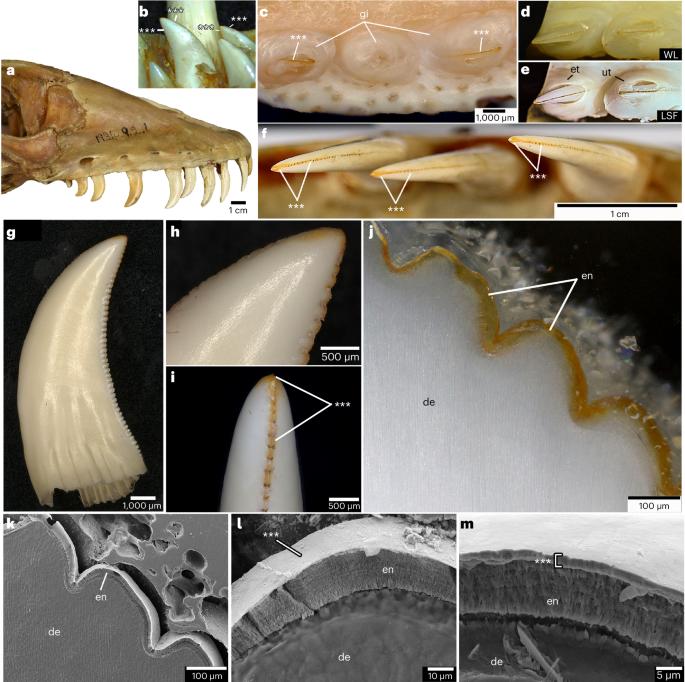铁涂层科莫多龙牙齿和食肉爬行动物复杂的牙釉质。
IF 13.9
1区 生物学
Q1 ECOLOGY
引用次数: 0
摘要
科莫多龙(Varanus komodoensis)是现存最大的食肉蜥蜴,它们的虹齿(锯齿状、弯曲状和叶片状)牙齿使它们成为研究牙齿结构、功能以及与已灭绝的虹齿类群(如兽脚类恐龙)进行比较的宝贵类群。与其他虹齿类爬行动物一样,科莫多龙的牙齿只有一层薄薄的珐琅质,但仍能满足它们穿刺拉动式进食的要求。利用先进的化学和结构成像技术,我们揭示了科莫多科爬行动物牙齿在保持其切割边缘方面的独特适应性:牙齿锯齿和尖端的橙色富铁涂层。通过与其他现存变齿类动物和鳄类动物的比较,我们发现铁螯合作用在爬行动物的珐琅质中可能很普遍,但在科莫多兽和与之密切相关的虹齿类动物中最为显著,这表明铁螯合作用在支撑锯齿方面起着至关重要的作用。不幸的是,由于化石的存在,我们无法在化石牙齿(包括箭齿类恐龙的牙齿)中持续发现类似的铁质涂层。然而,与科莫多龙不同的是,一些兽脚类恐龙的牙齿锯齿上有特殊的珐琅质,类似于食草的黑龙类恐龙的波浪形珐琅质。这些发现说明了掠食性爬行动物在维持栉齿方面意想不到的不同特化。本文章由计算机程序翻译,如有差异,请以英文原文为准。


Iron-coated Komodo dragon teeth and the complex dental enamel of carnivorous reptiles
Komodo dragons (Varanus komodoensis) are the largest extant predatory lizards and their ziphodont (serrated, curved and blade-shaped) teeth make them valuable analogues for studying tooth structure, function and comparing with extinct ziphodont taxa, such as theropod dinosaurs. Like other ziphodont reptiles, V. komodoensis teeth possess only a thin coating of enamel that is nevertheless able to cope with the demands of their puncture–pull feeding. Using advanced chemical and structural imaging, we reveal that V. komodoensis teeth possess a unique adaptation for maintaining their cutting edges: orange, iron-enriched coatings on their tooth serrations and tips. Comparisons with other extant varanids and crocodylians revealed that iron sequestration is probably widespread in reptile enamels but it is most striking in V. komodoensis and closely related ziphodont species, suggesting a crucial role in supporting serrated teeth. Unfortunately, fossilization confounds our ability to consistently detect similar iron coatings in fossil teeth, including those of ziphodont dinosaurs. However, unlike V. komodoensis, some theropods possessed specialized enamel along their tooth serrations, resembling the wavy enamel found in herbivorous hadrosaurid dinosaurs. These discoveries illustrate unexpected and disparate specializations for maintaining ziphodont teeth in predatory reptiles. Chemical and structural imaging of Komodo dragon teeth reveals that they maintain their sharp cutting edges through iron-enriched coatings, a unique adaptation compared with theropod dinosaurs (for which they have previously been used as an extant model).
求助全文
通过发布文献求助,成功后即可免费获取论文全文。
去求助
来源期刊

Nature ecology & evolution
Agricultural and Biological Sciences-Ecology, Evolution, Behavior and Systematics
CiteScore
22.20
自引率
2.40%
发文量
282
期刊介绍:
Nature Ecology & Evolution is interested in the full spectrum of ecological and evolutionary biology, encompassing approaches at the molecular, organismal, population, community and ecosystem levels, as well as relevant parts of the social sciences. Nature Ecology & Evolution provides a place where all researchers and policymakers interested in all aspects of life's diversity can come together to learn about the most accomplished and significant advances in the field and to discuss topical issues. An online-only monthly journal, our broad scope ensures that the research published reaches the widest possible audience of scientists.
 求助内容:
求助内容: 应助结果提醒方式:
应助结果提醒方式:


